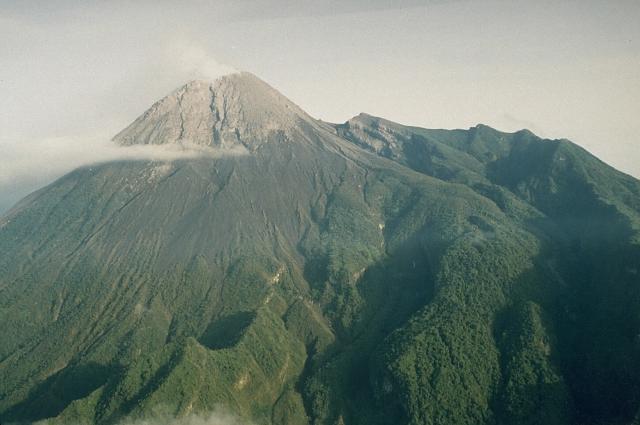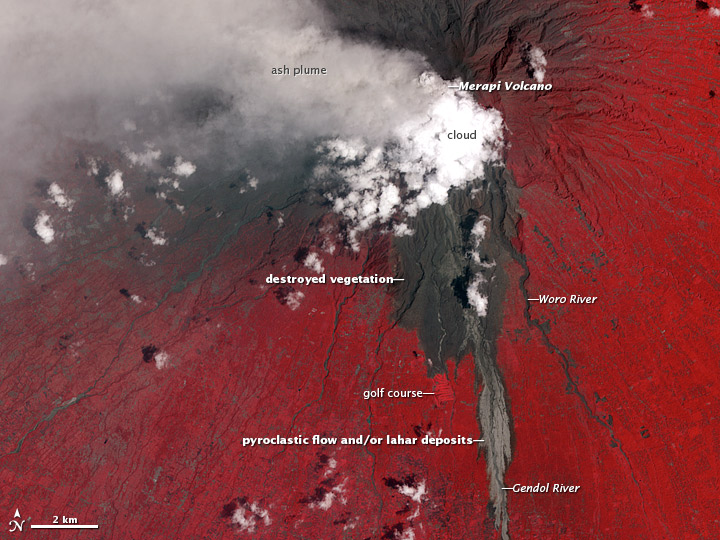Mount Merapi spewes smoke and ash, forces evacuations – Indonesia

Indonesian volcano Mount Merapi spewed smoke and ash on Monday, July 22, 2013. Heavy rain mixed with ash turned it to mud that fell on the ground and forced hundreds of people to evacuate villages along the slopes.
Though eruption is not yet confirmed, dark red volcanic material was observed rising 1 km into the air.
Darwin VAAC issued a report stating ash could not be seen via satellites due to clouds. The situation is still under observation.
Merapi, one of Indonesia's most active volcanoes, lies in one of the world's most densely populated areas and dominates the landscape immediately north of the major city of Yogyakarta.
Periodic collapses of its growing lava dome has produced pyroclastic flows and lahars that have devastated populated areas below the volcano in the past.

Image taken on November 10, 2010 – Image courtesy NASA/GSFC/METI/ERSDAC/JAROS, and the U.S./Japan ASTER Science Team.
Its last eruption began at about 17:00 on October 26, 2010 and was characterized by explosions along with pyroclastic flows that traveled WSW and SE. CVGHM reported that multiple pyroclastic flows occurred until 18:54, when the pyroclastic flow activity started to subside. Most of the pyroclastic flows lasted 2 to 9 minutes, except for two that lasted 33 minutes each. Booming noises were heard, and incandescence from the crater was seen from the Selo observation post to the N. An ash plume was also observed rising 1.5 km above the crater.
According to news articles, officials noted that about 15 000 people were not evacuated on the first day of eruption, even though several minor eruptions had already occurred prior to 26 October. Reports on October 27 noted that about 25 people died and several were injured. Eruptions were occurring until November 22, 2010. Almost 70 000 people were evacuated and 347 people lost their lives.
Last report by GVP was included in weekly report of September 7 – September 13, 2011: "CVGHM reported that during August 29 – September 4 white plumes rose at most 350 m above Merapi and drifted W. On September 4 small avalanches traveled 700 m SW. The Alert Level remained at 2 (on a scale of 1-4). Based on a pilot observation, the Darwin VAAC reported that on September 8 an ash plume rose to an altitude of 3.7 km (12,000 ft) a.s.l. and drifted almost 30 km N." (GVP)
Featured image: Merapi stratovolcano in central Java is capped by an unvegetated, growing lava-dome complex. The modern edifice of Merapi, at the left in this view, is constructed to the SE of the arcuate scarp on the right formed by destruction of the older Batulawang volcano. Merapi is one of Indonesia's most active volcanoes. Periodic collapse of its growing lava dome has produced pyroclastic flows and lahars that have devastated populated areas below the volcano. Photo by Yustinus Sulistiyo, 1994 (Volcanological Survey of Indonesia).

Commenting rules and guidelines
We value the thoughts and opinions of our readers and welcome healthy discussions on our website. In order to maintain a respectful and positive community, we ask that all commenters follow these rules:
We reserve the right to remove any comments that violate these rules. By commenting on our website, you agree to abide by these guidelines. Thank you for helping to create a positive and welcoming environment for all.